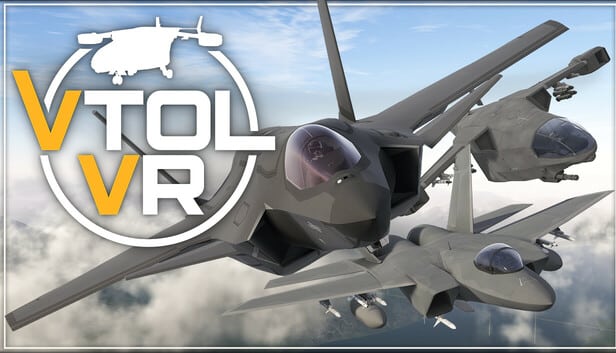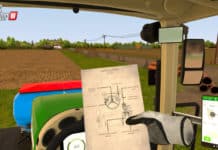Last Update on November 10, 2025
VTOL VR is a VR-first combat flight simulator: you actually operate the cockpit’s buttons, screens, and safety guards, arm and release weapons while reading instruments precisely, and manage energy, navigation, sensors, and threats as in real procedures.
No ghost HUD stuck to your eyes and no “video-gamey” UI: the aircraft responds to what you do with your hands. This guide takes you from your first flight to advanced co-op, covering PCVR settings, headset choice, multiplayer, DLC, and the Workshop (missions & mods).
Quick Facts
- Platform: PC (Steam, VR required) — runs via SteamVR.
- Headsets: any SteamVR-compatible HMD (Pimax Crystal Super for high-end clarity); Meta Quest 3 via Link cable or Virtual Desktop (PCVR streaming).
- Controls: VR controllers (native design). HOTAS not required (and generally not recommended for the “canonical” experience).
- Content: solo campaigns, quick missions, multiplayer (co-op & PvP), built-in mission editor, Workshop.
- Major DLC: AH-94 (attack helicopter, co-op crew), T-55 Tyro (trainer).
- External resources: official Steam page (modes, compatibility, reviews) and community wiki (procedures, aircraft, mission making).
Why VTOL VR Stands Apart?
VTOL VR’s originality comes from its natural interface: the airplane is the “character,” and the cockpit is the “controller.” Most sims inherit keyboard/HOTAS interfaces or 2D overlays ported to VR; VTOL VR flips that paradigm: VR controllers become your hands—arming a safety, aligning the INS, selecting radar modes, turning a brightness knob, or touching an MFD page.
This lowers the hardware barrier (no HOTAS required) while raising the bar for reading and procedure: to complete a mission in VTOL VR you must read and understand what you display, at the pace of a living cockpit. The result is immersion that turns learning into natural progression, you remember because you do.
Aircraft & Roles: Picking Your First VTOL VR Cockpit
F/A-26B — Multirole workhorse
Why we love it
The Swiss Army knife. In A/A, radar plus Fox-2/3 gives solid mid-range control; in A/G it carries a wide spread of guided (GBU, AGM) and unguided ordnance. The airframe is pedagogical: modern enough to automate some tasks, but never “too much.”
Who is it for?
Pilots who want to do everything (intercept, CAS, light SEAD) and learn systems progressively without burning out.
Good to know
Often the recommended starter: plenty of documentation and missions, including on Steam Workshop.
F-45A — Stealth with next-gen sensors
Why we love it
Advanced sensors, signature management, deep-strike capability. You discover sensor fusion logic: more “synthetic” situational awareness, excellent for delicate strikes and discreet detection.
Who is it for?
Pilots drawn to modern avionics, methodical planning, and deep strikes.
Good to know
Stealth is a tool, not a magic shield: altitude, routing, and timing discipline still matter.
AV-42C — VTOL (vertical takeoff/landing)
Why we love it
A highly flexible tilt platform: insertion/extraction, CAS, logistics. Handling is very different: VTOL transitions, power and attitude management.
Who is it for?
Players who enjoy fine control, helo/plane hybrid vibes, or multi-role groups that like co-op.
Good to know
Ideal for asymmetric co-op missions (transport, resupply, support).
DLC — AH-94 Attack Helicopter (two-crew)
Why we love it
Low-altitude combat: terrain masking, designation, CAS, pilot/CPG coordination. A two-person crew adds a unique social and tactical dimension.
Who is it for?
Duos who enjoy communication and role specialization.
Good to know
AH-94 showcases VR: head/eye placement, reading screens in turbulence, and verbal coordination are key.
DLC — T-55 Tyro Trainer
Why we love it
Perfect to professionalize fundamentals: patterns, simulated failures, clean procedures, precision landings.
Who is it for?
Serious beginners and squadrons that want a pilot nursery.
Good to know
Deceptively simple, it’s a superb learning tool for navigation and engine management basics.

Campaigns, Multiplayer & Editor: From Solo Sorties to Squadron Ops
Solo campaigns in VTOL VR ramp you up: short takeoffs, A/A, SEAD, carrier ops, TOT (Time On Target), naval threats, etc. The mission editor lets you craft scenarios with objectives, triggers, AI, and weather, then publish to the Workshop (where you’ll find campaigns, training missions, and templates).
In multiplayer, VTOL VR shines in co-op: flying as four with complementary roles (lead, wingman, JTAC overwatch, AV-42C logistics, AH-94 support) turns a mission into a coordinated operation. PvP exists (skirmishes, dogfights), but the magic is tactical co-op, where planning, radio procedures, and discipline make the difference.
Pro tip: one voice server per group (Discord), clear brevity codes, and a brief that’s short but structured (mission, weather, threats, routes, freqs, ROE, plan B/RTB).
PCVR Settings & Performance: Prioritize Clarity and Stability
The name of the game is stability and clarity: a crisp cockpit and steady frame-rate beat pretty screenshots that stutter. Start conservative, lock a floor FPS (ideally 80–90+ depending on HMD), then scale up.
Tuning sliders to test (in sequence):
- Resolution / SS (SteamVR/OpenXR/Virtual Desktop): start at 1.0×, then add +5–10% steps.
- Motion smoothing / ASW: helpful if FPS wobbles; test ON/OFF—artifacts can disrupt aiming.
- Anti-aliasing: try TAA first, then MSAA if your GPU can handle it.
- Shadows/details: set Medium/High first, avoid “Ultra” out of the gate; keep instruments razor-sharp.
- Codec & bitrate (Virtual Desktop): H.265 if available, moderate bitrate (≈40–70 Mbps on Wi-Fi 6/6E), router in line-of-sight.
- Network: prefer a dedicated 5/6 GHz channel, avoid background downloads.
Useful OVRdoz guides:
- PCVR streaming (Virtual Desktop): tuning & best practices → Virtual Desktop
- Connect SteamVR ↔ Quest 3 (Link cable/Wi-Fi) → How to connect SteamVR to Quest 3
- Gain FPS on gaming laptops → Optimize your gaming laptop for VR
Which Headset?
In simming, resolving power (resolution + sweet-spot sharpness) changes everything: reading MFD/HUD, visually spotting threats, and eye comfort over long flights.
- Pimax Crystal Super (PCVR Premium): very high pixel density, refined optics, generous sweet spot—ideal for VTOL VR if your priority is instrument legibility and fine visual cues. Pair it with a strong PC and you get a crystal-clear cockpit even in turbulence.
Compare it with a standalone headset in our Pimax Crystal Super vs Meta Quest 3 guide, and check our Best VR Headsets overview to have an idea about budgets, performance and use cases. - Meta Quest 3 (+ PC): outstanding value via Link or Virtual Desktop; perfect if you alternate between PCVR and standalone.
Pro tip: whatever the HMD, dial in IPD and fit precisely; on both Pimax Crystal Super and Quest 3, a few millimeters can transform MFD readability.
Getting Started in VTOL VR: A 10-Step Program (with concrete drills)
1) Setup & Comfort (30–45 min)
Clear a 2×2 m space, redo the guardian, set IPD to the millimeter, adjust the strap so your MFDs sit squarely in the sweet spot. In-game, reduce nuisances: cockpit screen brightness, label sizes, and lock a stable cadence (enable smoothing if needed). Sensitive to motion sickness? Start seated and avoid long rolls/turns. → OVRdoz guide: How to deal with motion sickness in VR. → OVRdoz Guide: How to Avoid Motion Sickness in VR?
2) Cockpit Familiarization (45–60 min)
In the F/A-26B, tour the interactive zones: breakers, APU, engine start, radio/nav, lights, weapon safeties. Goal: perform a cold-and-dark to taxi-ready without hesitation, and shut down cleanly. Drill: time a smooth start-up with zero errors.
3) Taxi, Takeoff, and Clean Landings (60–90 min)
Practice taxi (gentle turns, centerline), linear power-up, rotation, and a stabilized climb-out. For landing: flaps, approach speed, stabilized glide, go-around when needed. Drill: chain 5 touch-and-go’s in a left pattern, holding headings/altitudes.
4) Navigation & Radio (60 min)
Enter simple waypoints, fly heading/time (DR), and use visual references. Build a nav pattern: departure, turn point, return. Drill: a local flight with 2–3 waypoints and TOT within ±30 s.
5) Basic Air-to-Air (90 min)
Learn the radar: RWS/TWS (airframe-dependent), lock, IFF where available, crank/drag, FOX-2/3. Start vs. a non-maneuvering target, then a maneuvering bandit. Drill: 2 BVR engagements, maintain SA (situational awareness), RTB respecting fuel and altitude gates.
6) Basic Air-to-Ground (90–120 min)
Work with TGP (pod), steerpoints, GBU (laser/INS) and basic AGM. Drill: strike a light SAM zone with terrain masking, pop-up attack, clean egress, then exit.
7) VTOL/Helicopter Handling (90 min)
In AV-42C, practice transitions: hover → translation → airplane mode. Stabilize attitude, watch power/speeds. In AH-94 (if owned), swap pilot/CPG roles and tighten comms (“laser on,” “rifle,” altitudes, attack axes). Drill (duo): coordinated engagement on a moving convoy.
8) Emergencies (45–60 min)
Simulate engine failure, fire, degraded hydraulics. Drill: fast checklist, divert to an alternate, go-around if unstable. Anchor the reflex: aviate, navigate, communicate.
9) Structured Co-op (60–120 min)
Form a small group (4–6). Do a brief (mission, weather, threats), assign roles, set radio rules and a primary frequency. Drill: simple SEAD + strike; lead speaks little but clearly, everyone reads back. Debrief short and honest: fuel, ordnance, mistakes, improvements.
10) Mission Making & Workshop (variable)
Import a simple Workshop mission, then edit it: change weather/threats, add a trigger. Drill: publish a variant (author credits, changelog), then fly your own mission with the group. Resource: Community wiki (https://vtolvr.wiki.gg/) for editor logic and best practices.
Mods, Workshop & Community: Multiply Your “Useful Flight Hours”
The Steam Workshop is packed with campaigns and missions from pure training to narrative scenarios. Start with training sorties (pylons, circuits, basic A/A), then climb toward combined tasks (SEAD + strike + CAP). Join a squadron Discord: you’ll find brief templates, shared attack profiles, SOPs, and regular time slots. The built-in editor sustains your growth in VTOL VR: creating makes you a better pilot because you understand what you’re asking the player to do.
Common Issues in VTOL VR & Quick Fixes
- Micro-stutters in Wi-Fi streaming: move closer to the router, try H.265, lower bitrate, ensure no heavy downloads are active.
- Blurry cockpit: raise resolution gradually (SteamVR/OpenXR/VD), tune IPD, reseat the HMD, reduce AA if needed to recover text sharpness.
- Motion sickness: stabilize FPS first (80–90+), extend sessions gradually, prefer straight & level before maneuvering.
- Co-op lag & comms chaos: clean voice server, push-to-talk, short phraseology to avoid doubles.
- Bindings: start from default VR controller profiles, only change what truly hurts comfort (sensitive axes, recenter).
FAQ
Can I play VTOL VR on Quest 3 without a PC?
No. VTOL VR is a PCVR title: you need a SteamVR-compatible PC; use a Link cable or Virtual Desktop to stream from your PC.
Is HOTAS recommended?
The sim VTOL VR is designed for VR controllers. You can map a HOTAS through workarounds, but it’s not the native experience and you lose the hallmark hand-to-cockpit ergonomics.
Is there multiplayer on VTOL VR?
Yes: co-op & PvP. Co-op shines—complementary roles, two-crew in the AH-94, squadron-style missions.
How do I install missions?
Via Steam Workshop: subscribe to a mission/campaign and it appears in game. You can also build your own with the editor.
Which settings should I prioritize for comfort?
Stability first: steady cadence, TAA first, resolution at 1.0× then +5/10% increments, try smoothing, dedicate a clean Wi-Fi channel for streaming.
Which headset is best for VTOL VR?
For cockpit legibility, a high-definition PCVR like Pimax Crystal Super is ideal; Quest 3 + PC is a great versatility/value combo. → Pimax Crystal Super vs Meta Quest 3 • Best VR headsets
Bonus
For more VR simulation games, see our VR simulation games rankings.
External Resources
- Official Steam page (specs, modes, compatibility, reviews): https://store.steampowered.com/app/667970/VTOL_VR/
- VTOL VR community wiki (procedures, aircraft, mission editor): https://vtolvr.wiki.gg/
Verdict
VTOL VR isn’t “just another VR game”—it’s one of the rare sims built for VR, where your eyes and hands are the interface. Its depth is not merely missiles and checklists; it comes from the discipline it asks of the pilot and the natural way you learn by touching. With a well-tuned PC and a headset built for clarity (e.g., Pimax Crystal Super), you get a readable cockpit that makes every action safer, more precise, and above all, more immersive.











